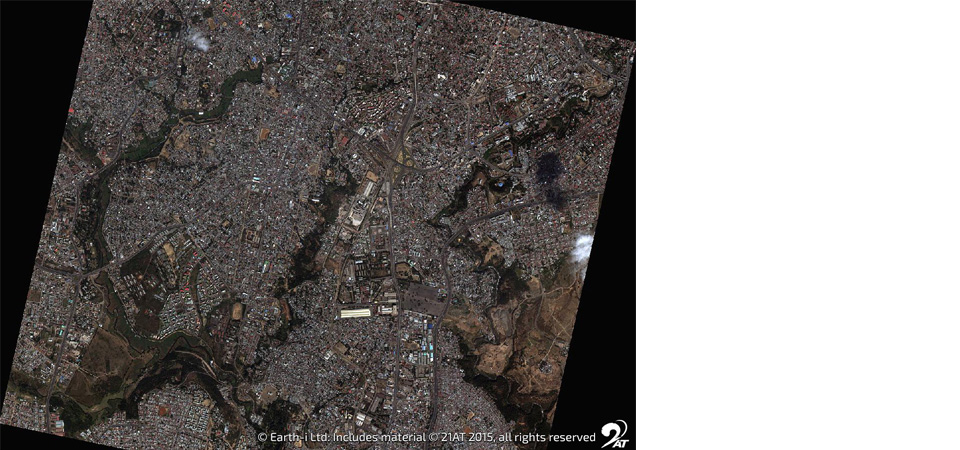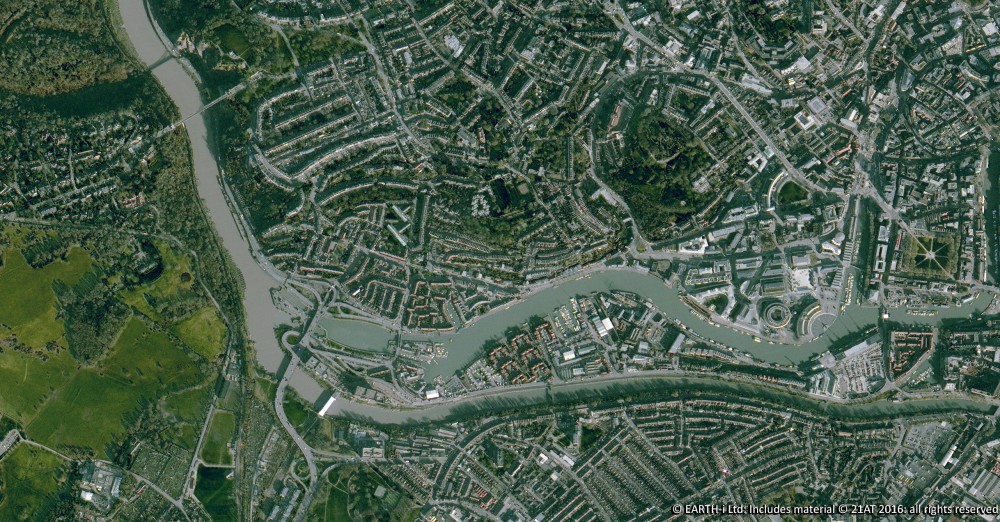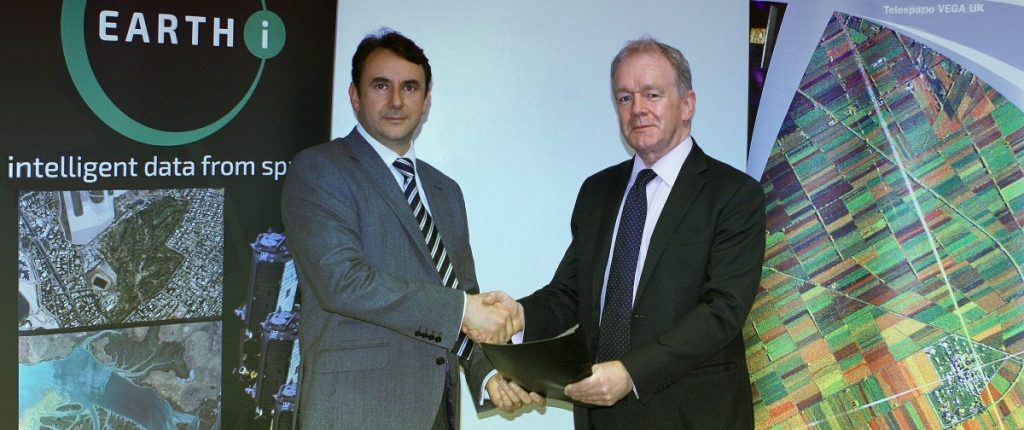Global Copper & Nickel Smelting Activities increase in September
- Surging copper smelting in Asia (ex China) & Oceania and Europe & Africa
- China copper smelting back down to March 2021 level, in time for LME Week…
- Nickel smelting activities driven by increases in Indonesia
- Europe & Africa nickel smelting remains the weak link
05 October 2022 – SAVANT, the unique geo-spatial analytics product launched in October 2019 by Earth-i and Marex, covers global smelting activity for both Copper and Nickel.
Sign-up here for a demonstration of the SAVANT service.
September 2022 Copper observations include:
Global smelting activity rose slightly in September, but despite this still registered an eighth consecutive reading below the two-year average of 50.0. A fall in Chinese smelting activity was the main reason – unsurprising at this point in the calendar as with LME Week at the end of the month, miners and smelters will soon begin negotiations around treatment and refining charges (TC/RC) for tonnages next year. Reducing smelting activity, at a time when a number of mines in South America face the threat of strike action and disruptions from local communities, could help alleviate any tightness that might be used as a bargaining chip by the mining side. In this context it is notable that we have yet to see any activity from Daye’s Hongsheng plant that has been due to commission for some months now. In the RoW – and despite operational issues at the Onsan smelter in South Korea – activity in Asia & Oceania soared to finish the month at its highest level since March 2016. Smelting in Europe & Africa also showed a healthy gain, although again it is notable that Zijin’s Bor smelter in Serbia is still showing as inactive, now nearly six months since it closed for maintenance in April.
- Global Dispersion Index rose to 49.0, up from 48.6 in August
- The China Dispersion Index fell for the fourth consecutive month to 44.8, its lowest level since March 2021
- This was offset by surging activity in Asia & Oceania and Europe & Africa where activity rose month-on-month by 10.5 and 5.7 points, to 63.3 and 51.9 respectively
- After climbing back above 50 in August, activity in South America fell back once again to 44.7
September 2022 Nickel observations include:
The Global Dispersion Index rose in September to 51.3, continuing the robust recovery from July’s record low of 37.8. This has been in large part due to the strong performance of NPI in Indonesia – where the commissioning of new lines across a number of sites has been clearly visible – as processing capacity rises to meet record mine production with the country now accounting for almost half of global upstream output. However this has been offset by further weakness in the NPI industry in China, where port inventories of nickel ore have been rising for several months. Although this is not uncommon ahead of rainy season, in combination with the low absolute volume of imports this year it is further indication of the ongoing weakness in downstream demand evident in our observations of declining smelting activity. Meanwhile in Europe, continuing energy price related disruptions are weighing on the regional and ferronickel indices as all three smelters in the continent’s South remain inactive.
- Global Dispersion Index rose to 51.3 from 50.1 in August
- This was despite the NPI Dispersion Index in China falling to 41.8, its lowest reading since February
- In Indonesia, the NPI Dispersion Index registered a second consecutive month above 60, at 60.8
- Europe & Africa remains the weakest performer globally, with the region’s Dispersion Index averaging 30.2 in September, albeit a modest rise from only 27 in August
Dr Guy Wolf, Marex’s Global Head of Analytics, commented: “This week’s national holidays in China and the heightened commercial sensitivity of smelting activities as we approach LME Week, means that we would like to defer judgement on the strength of any recovery in base metals’ supply chains as signalled by last week’s manufacturing PMI moving back into expansionary territory. Indeed, October can be something of a game of smoke and mirrors as onshore enterprises often return strongly in order to meet end of year output targets, while simultaneously trying to preserve the veil of a loose market that supports their negotiating position.”
Asia & Oceania and Europe & Africa Regional Dispersion Indices, Apr – Sep 2022 – Present (weekly average)
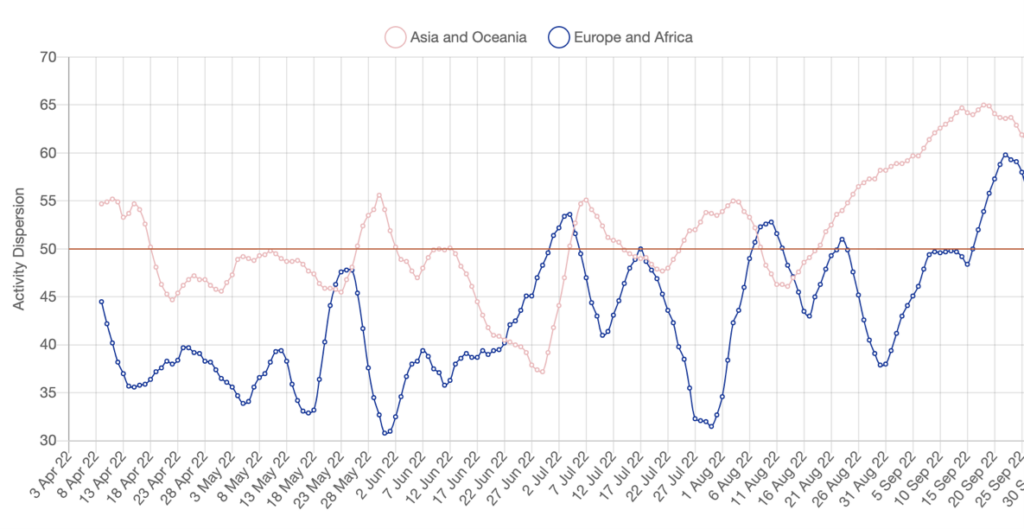
Indonesia Nickel Dispersion Index, Aug – Sep 2022 (weekly average)
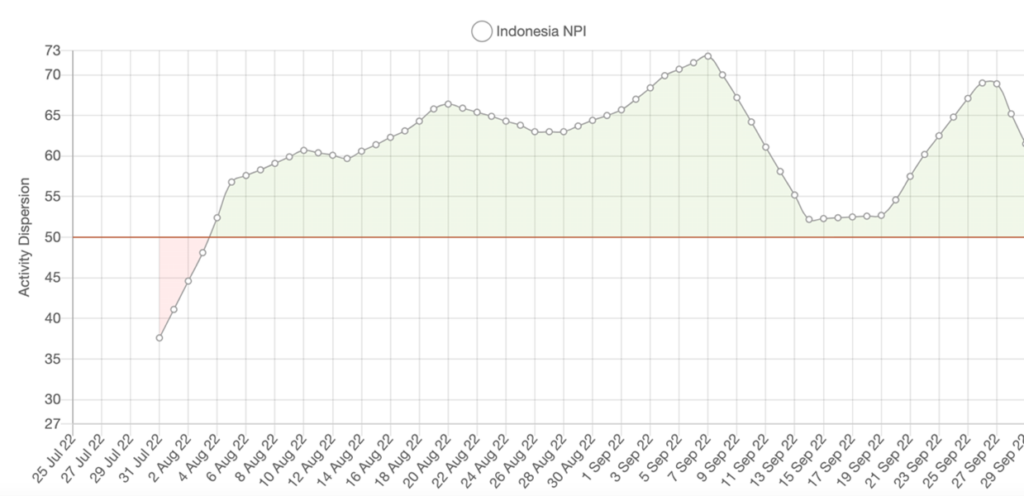
* – Index values go back to March 2016
The Activity Dispersion Index is a measure of capacity-weighted activity levels observed at smelter sites where a reading of 50 indicates that current activity levels are at average levels. Readings above or below 50 indicate greater or lesser activity levels than average, respectively. The above chart displays these readings as a weekly rolling average.
The Inactive Capacity Index is derived from binary observations of a smelter’s operational status as being either active or inactive. The capacity weighted global and regional indices show the percentage of smelter capacity that is inactive, with readings displayed in the chart below as a weekly rolling average. A reading of zero would indicate 100% smelting capacity.
The SAVANT platform monitors up to 90% of Copper and 96% of Nickel smelting capacity around the globe. Using daily updated sources, including extensive use of geospatial data collected from satellites, the index reports on the activities at the world’s smelting plants offering subscribers unprecedented levels of coverage, accuracy and reliability. This dataset allows users to make better informed and more timely trading decisions.
To find out more please visit SAVANT, or sign-up for the Free SAVANT service.
About Earth-i
Earth-i is a geospatial intelligence company using machine learning, artificial intelligence and Earth Observation data to provide unique and relevant insights, derived from diverse geospatial data, that deliver clear decision advantage for businesses, governments and other organisations.
Earth-i provides advanced analytics using automated interpretation of a range of geospatial Earth Observation data sources including colour imagery, colour video, infra-red and radar from a range of sources including satellite, drone, aerial and ground-based sensors. This data is fused with additional data sources to extract factual understanding and generate predictive insights across a range of markets such as commodities, supply chain, agriculture, infrastructure and defence.
For more information visit:
- Website: www.earthi.space
- LinkedIn: Earth-i
- Twitter: @Earthi_
To find out more please visit www.earthi.space.
For more information about this press release, please contact: info@earthi.co.uk
About Marex
Marex is a diversified global financial services platform, providing essential liquidity, market access and infrastructure services to clients in the energy, commodities and financial markets.
The Group provides comprehensive breadth and depth of coverage across five core services: Market Making, Execution and Clearing, Hedging and Investment Solutions, Price Discovery and Data & Advisory. It has a leading franchise in many major metals, energy and agricultural products, executing around 38 million trades and clearing over 193 million contracts in 2021. The Group provides access to the world’s major commodity markets, covering a broad range of clients that include some of the largest commodity producers, consumers and traders, banks, hedge funds and asset managers.
Marex was established in 2005 but through its subsidiaries can trace its roots in the commodity markets back almost 100 years. Headquartered in London with 22 offices worldwide, the Group has over 1,100 employees across Europe, Asia and America.
For more information visit www.marex.com.



